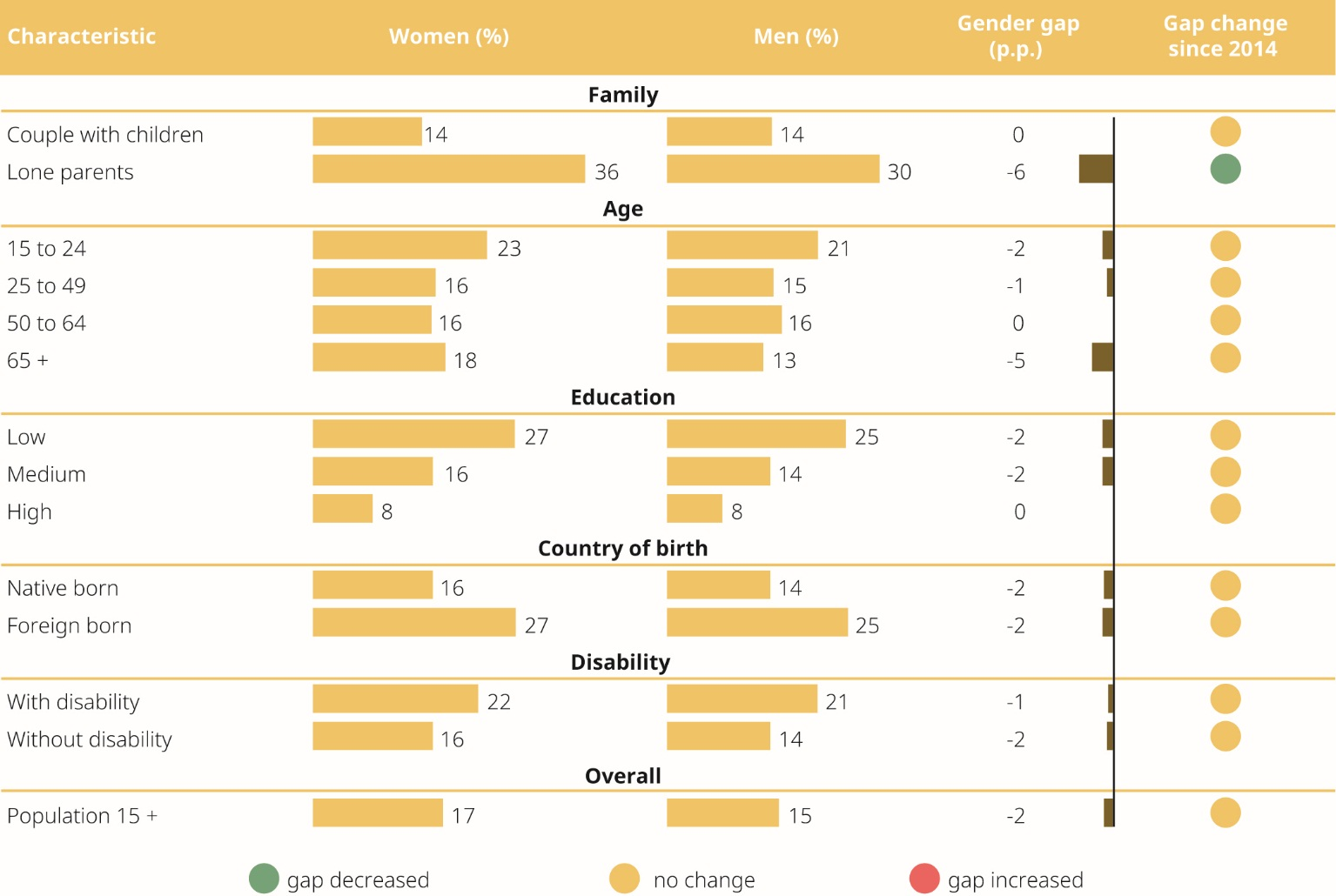Grave risk of poverty is the harsh reality for older women and every second lone mother
In 2010, the Europe 2020 strategy established a 10-year EU target to lift at least 20 million people out of the risk of poverty or social exclusion. Since then, the total number of women and men at risk of poverty or social exclusion has reduced by 8 million, welcome progress that nevertheless falls short of the target. In 2018, of the 21 Member States with national anti-poverty targets for the whole population, only eight countries had achieved them[1].
Across the EU, the difference between women and men at risk of poverty is 1.9 p.p., to the detriment of women, and has not improved since 2010. Given that incomes are typically measured at household level, assuming equal sharing of resources within households, this gender gap is likely to underestimate women’s true exposure to poverty.
Gender gaps in poverty have increased in 14 Member States since 2010 and have been on the rise in 21 Member States since 2017. The biggest increases since 2010 have been observed in Lithuania, Latvia and Estonia. Cyprus, Slovenia and France have shown most progress on closing their gender gaps (see Table 13 in Annex 3).
Poverty and social exclusion are often concentrated in certain particularly vulnerable groups of women and men (Figure 10). For instance, having children exacerbates the risk of poverty, with almost 4 in 10 lone parents – mostly lone mothers – at risk. Lone parents are also at a much higher risk of being deprived of acceptable housing and living conditions than other family types.
For example, compared with other households, many more lone mothers with dependent children live in a dwelling with a leaking roof, damp walls, floors or foundations, or rot in window frames or floors[2]. Although older people are less exposed to poverty than younger cohorts, the gender gap in poverty is largest among those aged 65 or older (18 % for women and 13 % for men). Women over 65 are at higher persistent risk of poverty during the preceding 3 years (12 % of women, compared with 8 % of men)[3].
Figure 10. At risk of poverty rate by sex, family composition, age, education level, country of birth and disability, EU, 2018
Older women are more likely than men to live in deprivation, for example enduring overcrowded conditions (7 % and 5 %, respectively in 2018). They are also more overburdened with housing costs representing more than 40 % of the total disposable household income (12 % of women, compared with 9 % of men). The gender gap in in-work poverty is also highest among women and men over 65 (11 % and 8 %, respectively).
The risk of poverty is higher among women and men with disabilities, women and men with a low level of education, and migrant populations. In addition, four out of five members of Roma communities have incomes below the poverty threshold in their country of residence (EIGE, 2020a).
The increased risk of poverty or social exclusion for the abovementioned groups is often associated with a combination of unemployment or inactivity, low work intensity at household level, low educational attainment, poor working conditions, insufficient financial resources, material deprivation and/or discrimination (EIGE, 2020a).
Whether and how women work is usually determined by their disproportionate caring and other household responsibilities. Such responsibilities are associated with unequal time-use patterns, which then result in time poverty (Francavilla et al., 2012). Women’s employment decreases with the number of children in the family. Care responsibilities keep 7.7 million women out of the labour market. Nearly five times more women than men (29 % and 6 %, respectively) work part-time to care for children and other dependent family members.
Lower salaries, a higher likelihood of working in atypical jobs (e.g. in the informal sector) and career breaks to care for dependants all result in women facing higher risks of poverty throughout their entire life course.
The higher risk of poverty goes hand in hand with multiple other inequalities faced by women and thus require a coordinated policy response. Lone mothers, older women and women with lower socioeconomic status are at greater risk of poor physical and mental health, while typically limited resources make them more vulnerable to energy poverty as well. High levels of economic inequality have detrimental effects on children’s well-being and on economic growth (OECD, 2015, 2019b; Pickett and Wilkinson, 2007).
FRA’s survey research in nine EU Member States (Bulgaria, Croatia, Czechia, Greece, Hungary, Portugal, Romania, Slovakia, Spain) found that 72 % of Roma women aged 16–24 are neither working nor in education or training, compared with 55 % of young Roma men. Poverty is considered a major factor underpinning early marriage, which, while often part of an economic survival strategy, undermines the future prospects of young women and girls (FRA, 2016a).
